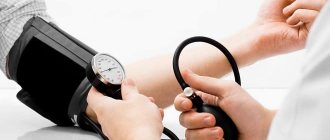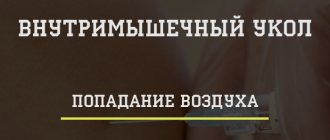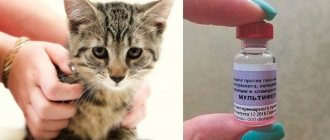Children should be given injections by a healthcare worker, but parents sometimes face situations where they have to pick up a syringe and administer injections themselves.
Proper implementation of the procedure reduces the risk of infection and other negative reactions. It is useful for all parents to know how to give an injection in the buttock of a child.
Intravenous administration of drugs should only be carried out by a person with medical education.
Rules and features of the procedure
Intramuscular injections require careful attention from parents to the nuances:
- you need to be confident in your abilities;
- It is useful to watch a video on how to give an injection to children in the buttock area;
- it is advisable to have an assistant to carry out a medical procedure if the child is no more than five or six years old;
- it is important to clarify how to dilute the drug (if necessary);
- be sure to follow the rules of asepsis and antisepsis to avoid infection during injection;
- it is important to ensure that all the air comes out of the syringe before injecting;
- It is necessary to properly prepare a young patient for a medical procedure, taking into account age and temperament. You cannot tell scary stories, scare people with evil doctors, or say that “only bad children are afraid of injections”;
- it is important to be persistent, to understand that without timely injections, recovery is impossible;
- The best option is to inject the child in the buttock while calmly stopping. If a small patient is hysterical, then you need to wait a while, calm the screamer, then carry out the procedure;
- Adults should not show fear of medical manipulation, especially preschoolers. It is useful to explain to elders that, despite some fear of intramuscular injection of the composition, you need to overcome yourself and understand that injections speed up recovery and prevent dangerous complications.
If a child has an allergy to medications, the injections should be given by a nurse. If it is not possible to get specialist help, then parents should always have a fast-acting antihistamine on hand.
If you have to give an intramuscular injection to a child at home, then you need to know how to eliminate a possible immune response to the injection composition using antiallergic names.
The first generation tablets give a good effect within 15-20 minutes: Suprastin, Tavegil, Diazolin dragees. The instructions indicate the age of the child to use a specific medicine.
Where to inject vaccinations?
Let's start with a letter. One of many on this topic, but perhaps the most revealing and the cup of peaceful patience overflowing.
So:
“Hello, Evgeniy Olegovich! I am sure that most letters to you begin with words of gratitude. And this letter is no exception. I have a wonderful son, Vanya, who turned 9 months old today. We live exclusively according to your recommendations and are incredibly happy.
But I am writing for a different reason. And this reason is very significant - vaccinations. A few weeks ago Vanya received the 3rd DTP vaccination. It is strange that a 9 month old child received his legal vaccination so late. But it’s strange, probably, in America or England. We say “Thank you” for this too. We waited 4 months for the vaccine. Having rushed to the clinic on wings (“Hurray! The vaccine has arrived!”) and received a referral for vaccination, my joy was over. I had to quarrel once again with the nurse who was giving the injection. The first thing she said was “Take off your diaper.” To the question “Why? The thigh is already bare!” - She threw the instructions for Infanrix in my face, which I read very carefully. The previous time, general recommendations were thrown in my face, where it was written that DTP is a vaccination that is given intramuscularly. I generally remain silent about the stream of unpleasant words. As a result, DPT was still performed in the thigh, but with great scandal and insults. My boy started crying a lot from the nurse’s screams even before the injection... I went to the manager, who told me not to worry next time, because... it is possible and necessary to inject into the buttock, “it’s softer there” (his words).
I searched the entire Internet, but could not find a document indicating the location of the DPT injection. I trust you without complaint, which is why I complain about my child’s hip every time. Evgeniy Olegovich, how can I document that I am right? After all, somewhere there are these rules and recommendations...
Thank you. Tatiana, mother of a gorgeous son..."
Probably a separate issue is nurses who allow themselves to yell and throw. It would seem, well, what difference does it make to you where to give the injection? Well, mom asks me to do it in the thigh. Is this not possible, is this wrong? Well, do it, and you’ll kick the rest of the butts for your own pleasure... But no, what a joy it is to throw, yell, enjoy your momentary power and eternal impunity, ruin a mother’s mood, scare a child...
Anyway. Let's look at the official documents.
For residents of Russia - and for medical workers in Russia as well, there is a fundamental document called:
ENSURING IMMUNIZATION SAFETY
Sanitary and epidemiological rules
SP 3.3.2342-08
The document was developed in accordance with Federal Law N 52-FZ “On the Sanitary and Epidemiological Welfare of the Population” and came into force on June 1, 2008. Quoting from paragraph 3.37 of this document:
“Intramuscular injections for children of the first years of life are carried out only in the upper outer surface of the middle part of the thigh”.
***
There is no such document in Ukraine and there is no time to write it - everyone is working on healthcare reform. Therefore, it is somewhat more difficult to prove the case - there are a lot of documents and they all say approximately the same thing, but, we repeat, there is no one single one that has the force of law for a particularly smart nurse.
Let's start with the textbook approved by the Ministry of Health for students of medical universities “CURRENT ISSUES IN VACCINE PREVENTION OF INFECTIOUS DISEASES IN CHILDREN” (Ternopil, 2001).
Quote (clause 1.6. p. 15, translation from Ukrainian): “ The intramuscular route of administration is the main one for sorbed and inactivated drugs (DPT, ADS, hepatitis B, split influenza vaccines), since local reactions are less pronounced. At the present stage, it has been proven that the introduction of vaccines into the gluteal muscle (superior outer quadrant) is dangerous due to the possibility of damage to nerve trunks if they are abnormally located, which is observed in 5% of children. Moreover, adipose tissue predominates in the buttock area, and the introduction of a vaccine preparation into adipose tissue significantly reduces the percentage of antigen absorption, which may affect the effectiveness of the formation of post-vaccination immunity. Therefore, the main injection site should be considered the outer surface of the thigh, where the muscle is located shallowly and has no nerve trunks .”
According to the “Regulations on the organization and conduct of preventive vaccinations and tuberculin diagnostics” (approved by the Ministry of Health on September 16, 2011), vaccinations are carried out in accordance with the Calendar of Preventive Vaccinations and approved instructions for the use of the vaccine (clause 6 of the mentioned regulation).
Thus, the fundamental document regulating the place of vaccine administration according to Ukrainian legislation is the instructions for use of the vaccine.
Let's look at the instructions.
INFANRIX.
“The vaccine is intended for deep intramuscular injection. For infants, the preferred injection site is the anterolateral thigh; for older children, the vaccine should be injected into the deltoid muscle.”
PENTAXIM.
In the Russian instructions “... the recommended injection site is the middle third of the anterolateral surface of the thigh,” in the Ukrainian instructions the recommended injection site is not indicated, it simply states the need for deep intramuscular injection.
ANGERIX B and other vaccines for the prevention of hepatitis B.
“I/m, in the area of the deltoid muscle (adults and older children) or in the anterolateral region of the thigh (in newborns and young children). Administration to another site is undesirable due to a decrease in the effectiveness of vaccination.”
***
If the laws of Russia and Ukraine are not enough for some nervous nurses, you can refer to the opinion of the WHO. When regulating the rules and techniques of vaccination, the WHO website provides a link to a number of authoritative sources, primarily to the US Center for Disease Control and Prevention - CDC.
CDC information:
“Two locations are recommended for vaccine administration:
- Vastus lateralis muscle (anterolateral part of the thigh).
- Deltoid muscle (shoulder).
Injecting into these areas reduces the likelihood of damage to nerve and vascular structures. For most children, the anterolateral thigh is the recommended injection site. The buttock muscles are not used to administer vaccines to infants and children due to the potential risk of sciatic nerve damage.”
***
Note. There is a very specific question: “Where should vaccines be injected that are to be administered intramuscularly?” There is a very specific answer that is taught to students in medical schools and which is formulated in many pieces of legislation. This answer is already known to all our readers.
But, despite all of the above, it turns out that we have not just doctors, but doctors who are in charge of departments and who claim that it is not only possible, but also necessary (!!!) to inject into the buttocks, guided by the amazing argument: “it’s softer there” ...
***
Girls, let's finally do something! Well, we have no right to rely on doctors and nurses, for whom it is easier to inject buttocks, since they are larger and softer! These are your children!
Well, should you take a piece of paper, print on it the recommendations of civilized medicine and attach it (this piece of paper) to the doors of the vaccination office or hang it on a stand with medical propaganda, which can be found in the corridor of any clinic? Or print a lot of these pieces of paper and give it to every mom who sits in line with you at the vaccination office.
The main thing is, when you prepare such a piece of paper, follow three simple rules:
Rule 1.
Be sure to write in capital letters:
Intramuscular administration of vaccines to children of the first years of life is carried out only in the upper outer surface of the middle part of the thigh.
Rule 2.
Be sure to explain and write why!
In children of the first years of life, vaccines are administered intramuscularly not into the buttock, but only into the upper outer surface of the thigh, because:
- injection of vaccines into the gluteal muscle is dangerous due to the possibility of damage to nerve trunks if they are abnormally located, which is observed in 5% of children;
- in the area of the thigh where intramuscular injection of vaccines is recommended, there are no large vascular or nerve formations, so it is absolutely impossible to damage anything;
- in the buttock area, adipose tissue predominates, and the introduction of the drug into adipose tissue reduces the effectiveness of the formation of immunity.
Rule 3.
Do not under any circumstances refer to Dr. Komarovsky! Refer only to official documents!
author Komarovsky E.O. published 06/09/2012 16:18 updated 06/08/2019
What is needed for the injection
To carry out intramuscular injections at home, you will need several components:
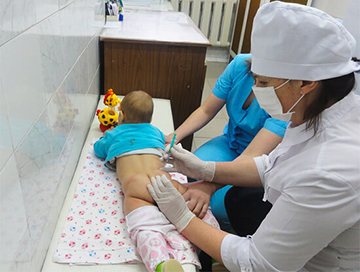
- prescribed drug. If the doctor has prescribed a lyophilisate (powder for injection) or a thick suspension, then be sure to buy special water or medicine at the pharmacy to dilute the composition. Be sure to check the availability of instructions for the drug;
- syringe of a certain cubic capacity. Children in most cases need a volume of 2 or 5 cubes. Many pharmacies offer special “children’s” syringes, in which the needle is thinner and shorter;
- medical alcohol;
- packing of sterile cotton wool.
Preparing for the injection
Important points:

- thoroughly disinfect your hands: antibacterial soap, alcohol or an antiseptic solution are suitable;
- prepare the medicine correctly (some drugs need to be mixed with lidocaine, water for injection or other components);
- you need to remove the syringe from the sealed package and attach the needle;
- it is important to carefully open the container with the drug using a cutting device, which in most cases is located in the box with ampoules;
- after drawing in the liquid, turn the syringe over so that the needle points up, lightly tap the container with the medicine several times with your fingernail: at this moment, air bubbles rise closer to the hole. Be sure to press the plunger so that a few drops of the drug come out of the needle or a thin stream of the medicinal solution appears. An injection in the buttock can be done after treating the edge of the needle with a cotton swab on which alcohol has been applied;
- after the procedure, the young patient should rest, lie in bed;
- It is important to put the cap on the used needle, and only after this manipulation place the waste material in the trash bin. The syringe must also be thrown away: it is prohibited to reuse the injection device;
- If there is a sharp reddening of the injection area, a rise in temperature, or an anaphylactic reaction (a severe form of allergy with pronounced swelling), you should immediately dial an ambulance.
Preparing for intramuscular injection to a child - detailed instructions.
- First, wash your hands thoroughly with soap and wipe them with medical alcohol.
- Unless otherwise prescribed by the doctor, the injection is given into the gluteal muscle . Determining the “point” for the injection is not difficult: mentally divide the buttock (and not the whole butt!) into 4 squares and “aim” at the upper right square (if the buttock is right). For the left buttock, the square, accordingly, will be the upper left.
- We remain calm, otherwise the baby will instantly feel your panic, and it will be very difficult to give the injection. The more confident and relaxed you are and, most importantly, the baby, the easier the needle will go in.
- Wipe the ampoule with alcohol , dry cotton wool or a piece of sterile gauze. We make an incision on the ampoule - along the line of the supposed fracture. For this, a special nail file is used (usually included in the package). It is strictly forbidden to beat off, break off, or “bite off” the tip of the ampoule without this tool - there is a risk that small fragments will get inside.
- Unpack the disposable syringe from the piston side.
- We connect it to the needle without removing the protective cap from the needle.
- If the medicine in the ampoule is in dry form, dilute it, according to the instructions and doctor’s prescription, with water for injection or another drug prescribed by the doctor.
- Remove the cap from the needle and draw the required amount of the drug into the syringe.
- Be sure to remove air from the syringe. To do this, lift the syringe with the needle up, lightly tap the syringe with your finger so that all the air bubbles rise closer to the hole (to the needle). We press the piston, expelling the air out.
- If everything is correct , a drop of the drug will appear on the hole of the needle. Remove the drop with a cotton swab soaked in alcohol and put on the cap.
Advice: we carry out all preparatory manipulations so that the baby does not see them - do not frighten the baby in advance. We leave the prepared syringe with the medicine (and with the cap on the needle) on a clean saucer on the shelf/table and only then call/bring the child into the room.
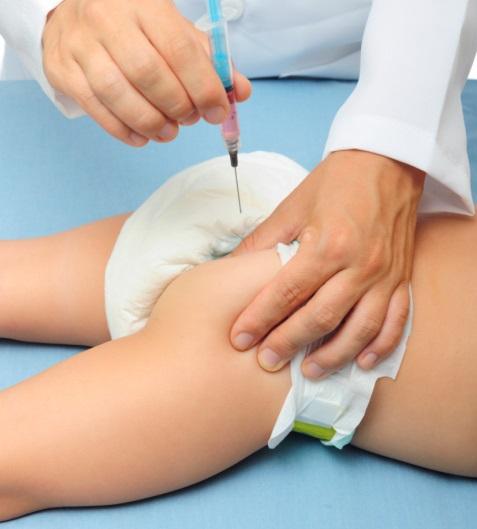
How to set up a child for an injection
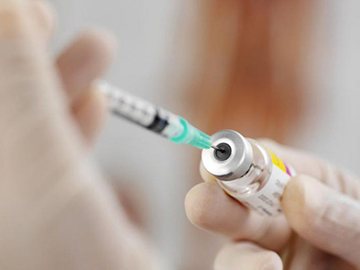
The conclusion is not difficult to draw: the more attention adults pay to the intellectual and moral education of a child, the easier it is to explain even to a two-year-old toddler why injections are needed and to achieve adequate behavior.
Unfortunately, many children are capricious, break out of their hands, cry, try to run away, and bite. What to do in such a difficult situation? It is important to stop the hysteria, calm the young patient down, distract him with a toy, an interesting story, music, a song, or an age-appropriate gadget. You need to hug the child, take him in your arms, walk around the room, rock him a little, if the weight of the whim allows, promise a small surprise after the procedure.
It is advisable to remain calm, although this is very difficult, but there is no other way out: if the mother begins to scream and get nervous, then all parties to the conflict suffer. You should not hit the baby: aggression will provoke an increase in hysteria.
Many mothers say that the game “to the hospital” helps a lot when kids treat dolls and animals. The little “doctor” explains to the “patients” what the injections are for and gets used to the idea that during a serious illness one cannot do without an important procedure. The task of parents is to provide information about medical procedures in an accessible, interesting, age-appropriate manner.
Intramuscular injection in the buttock
Injection rules:

- Before the injection, you need to wash your hands with a soap or alcohol disinfectant solution;
- Next, the assistant should take the small child in his arms and place him on his stomach. Older children should be asked to lie on the sofa in the same position;
- before the injection you need to rub your hands and warm them up;
- prepare the medicine, draw it into the syringe, release excess air (press the plunger so that a little liquid flows out of the needle);
- the first stage is to disinfect the injection area using a cotton swab moistened with alcohol;
- the second stage is to mentally divide the buttock into four squares: the drug is injected into the upper outer area;
- the third stage is to collect the skin in this area with your left hand (the syringe is in your right hand), insert the needle at a right angle (about ¾ of its length). The movements are sharp, but confident and controlled. There is no need to be afraid, it is important to carry out the manipulation calmly;
- after inserting the needle, you need to quickly place your thumb on the piston and fix the syringe using the middle and index fingers;
- the fourth stage is the slow administration of the drug: the injection in the child’s buttock is prohibited in a hurry. When there is no medicine left in the syringe, you need to take a cotton swab soaked in alcohol with your free hand, press down a little on the injection area, quickly take out the needle, gently but firmly press the hole;
- the final stage is a gentle massage of the injection area with a cotton swab containing a disinfectant composition. There is no need to rub the area where the needle is inserted: just gently massage the desired area. For one to two minutes, the adult holds the cotton wool in the same position to avoid removing drops of blood;
- After the injection, you need to praise the child for his patience, give preschoolers a small “reward”, for example, a lollipop, and say that now he will recover faster.
The syringe must be inserted with the main (working) hand, taking into account whether the parent is left-handed or right-handed.
Intramuscular injection technique for young children - video on how to give an injection to a child.
- With warm hands, massage the buttock “for an injection” - gently and gently to “disperse the blood” and relax the gluteal muscle.
- Calm the baby, distract him so that he is not afraid. Turn on a cartoon, call your dad dressed up as a clown, or give your baby a toy syringe and a teddy bear - let him also “give an injection” at that very moment - one-two-three. The ideal option is to distract the baby so that he does not notice the moment when you raise the syringe over his butt. This way the gluteal muscle will be more relaxed, and the injection itself will be less painful and quicker.
- Wipe the injection site with cotton wool (a piece of gauze) moistened with alcohol - from left to right.
- Remove the cap from the syringe.
- With your free hand, gather the desired gluteal “square” into a fold (for adults, injections, on the contrary, stretch the skin).
- Using a quick, firm, but controlled motion, insert the needle at a 90-degree angle. We insert the needle to a depth of three-quarters of its length. The injection is intramuscular, so when you insert the needle to a shallower depth, you reduce the therapeutic effect of the drug and create “soil” for the appearance of a subcutaneous lump.
- The thumb is on the piston, and with the middle and index fingers we fix the syringe in the hand. Press the plunger and slowly inject the medicine.
- Next, lightly press the place where the needle is inserted with cotton wool soaked in alcohol (prepare in advance), and quickly remove the needle.
- Using the same cotton swab, press the hole from the needle , lightly massaging the skin for a few seconds.
What not to do
Parents should remember a few rules:
- You cannot scare your baby with injections and doctors as punishment for bad behavior;
- There is no need to show your son or daughter that adults themselves are afraid of injections or do not cope well with the role of a “home nurse.” Children subtly sense their parents’ insecurity and begin to act up and panic;
- it is not worth saying that there is no pain during the injection: after deception, the child will not trust adults, it will be more difficult to carry out the next procedure;
- there is no need to carry out preparatory manipulations (mix the medicine, unpack the syringe, draw liquid into a container) in front of the child’s eyes;
- You cannot shout at the baby and, especially, beat him if the little one screams and breaks out before the procedure. Spanking and threats add to the stress many children experience during medical procedures.
An important point is compliance with the rules of injection. You can’t be negligent about procedures at home: haste, re-using a syringe, improper dilution of medications, insufficient sterility of hands, injection areas, and medical devices are factors that increase the risk of complications after intramuscular administration of the drug.
Many parents have to give injections to their child’s buttocks themselves at least once in their life. The more information on this topic, the easier it is to avoid mistakes and complications after a medical procedure.


